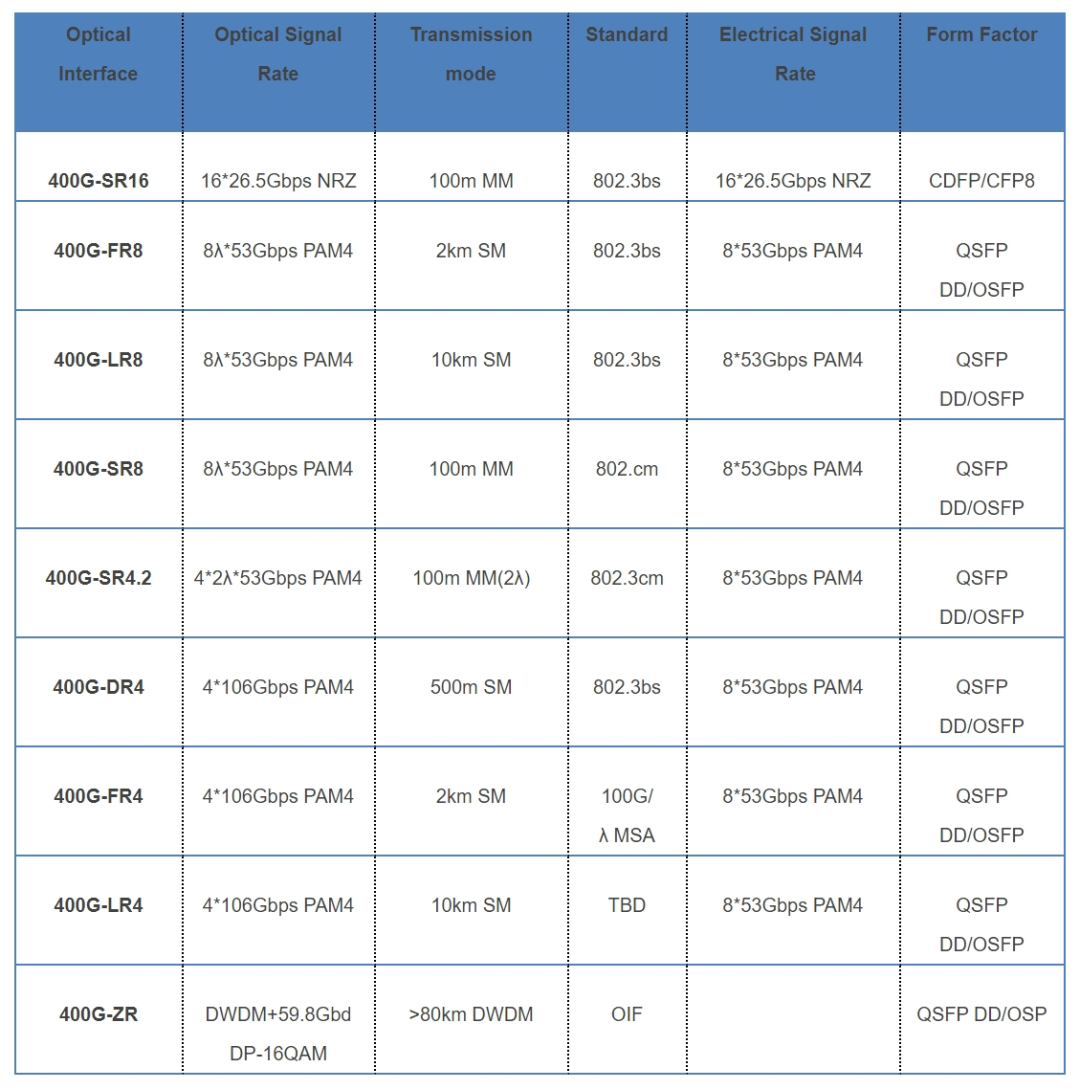

 Knowledge Base +
Knowledge Base +  2024.01.05
2024.01.05QSFP-DD is called "Quad Small Form Factor Pluggable-Double Density", which is a high-speed, small, pluggable packaging mode defined by the QSFP-DD MSA group.QSFP-DD is backward and forward compatible with QSFP ports. It is also compatible with existing QSFP28 optical modules and AOCs/DACs, etc.
QSFP-DD can achieve up to 14.4Tb/s aggregated bandwidth in a single switch slot, and its common subcategories are compared below:

The 400G DR4 is an optical transceiver module designed for 400G Ethernet data center interconnect in a QSFP-DD form factor. At the transmitter side, the DR4 module converts eight 50Gb/s PAM4 electrical signaling channels into four parallel optical output data channels, each with a data rate of 100Gb/s for a total bandwidth of 400Gb/s.
At the receiving end, the optical transceiver converts four channels of 100Gbp/s parallel optical data into 400Gbp/s aggregation to support eight channels of 50Gb/s PAM4 electrical output signals.
Figure 400G QSFP-DD
The 400G QSFP-DR4 optical module adopts standard MPO-12 connector and can transmit up to 500m via single-mode fiber, and can also support connection with 100G DR optical module. It adopts 1310nm EML transmitter type, and the signal is modulated by PAM4 pulse amplitude modulation.
_1705462808.png)
_1705462820.png)
Application Scenarios
With the maturity of industry standards and network requirements, 400G optical modules have led the development of the optical communication industry, especially in the following three application scenarios that have gained more and more attention: data centers, metro bearer networks, and long-distance high-capacity transmission networks.
Data Center
400G Data Center Network Optical Module Solution (Background: Rapid East-West Traffic Growth)
By 2021, about 70% of data center east-west traffic will remain within the data center, and the growth rate is expected to be much higher than that of north-south traffic and traffic between data centers, thus greatly increasing the demand for high-speed optical modules.
North American OTT customers plan to start deploying 400G solutions in 2020. Starting in the first half of 2019, Chinese OTT customers have also initiated the first 400G tests in China involving multiple 400G optical module vendors.
Metro Bearer Networks
400G Optical Module Solution for Metro Networks (Background: New Services Drive Traffic Growth in the 5G Era)
With the rapid development of 5G, new services including ultra-high-definition video, IoT, VR/AR, and Telematics put new requirements on bearer networks: ultra-high bandwidth, massive connectivity, ultra-low latency, and high reliability.
Existing 100GE ports in MANs cannot support the aggregation and core layers that require ultra-broadband, and the demand for 400GE optical interconnect solutions has arisen.
Take 5G bearer networks as an example. According to the Next Generation Mobile Network (NGMN) Alliance's bandwidth assessment, during large-scale 5G commercialization of metro networks, the access layer bandwidth will grow to 50GE, while the core layer bandwidth will grow to 200GE/400GE.
Long-haul, high-capacity transmission networks
400G Optical Module Solution for DWDM Networks (Background: Traffic Growth Adds Bandwidth Pressure to Long Distance Transmission)
Growth in network traffic leads to an increase in port bandwidth on the transmission network. For long-haul and high-bandwidth transmission, wavelength-division-multiplexer (WDM)-based coherent transmission technology offers the best solution.
As 400G coherent solutions mature, the demand for 400G coherent ports will grow rapidly beyond 2020.
There are two drivers for the growth of 400G coherent ports: growth in network bandwidth and an increase in the number of 400GE ports on the client side.
According to LightCounting's forecast report, 400G coherent ports will be used in more and more networks and will see the fastest growth over the next five years.
How to choose an appropriate optical fiber jumper for the QSFP-DD 800G optical module
What is the difference between QSFP DD and QSFP28 DD
Subscribe to the newsletter
for all the latest updates.
2-5# Building, Tongfuyu Industrial Zone, Aiqun Road, Shiyan Street, Baoan District, Shenzhen. China
